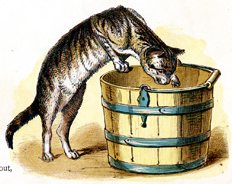
The idea that cats enjoy drinking milk has been propagated for ages. Whether though iconic images, or charming stories of stray cats lapping up fresh cows’ milk from china bowls, it seems to be the go-to food source for visiting kitties. But where did this idea come from, and what makes it so widely de-bunked now?
Where did the idea of milk come from?
Like many a wives’ tale, the idea that we should feed cats with cow or goat milk most likely originated from historical and literary references. Shakespeare proved that this concept has been around for centuries, as he wrote the following line in his play “The Tempest”:
For all the rest
They’ll take suggestions as a cat laps milk
It does not seem far-fetched to imagine stray cats scratching at medieval cottage doors or farmhouses in hopes of receiving scraps to eat. No matter how lowly or impoverished the inhabitants of the household might have been, most people take pity on lost creatures. While the idea of sharing what scarce food the family had might have seemed impossible with many mouths to feed, sending a hungry animal away would have been heartless. So it is likely that people would then look for something that was always in ready supply: milk. Without taking from the precious morsels of food intended for the working livestock and family, a woman could spare a partial bowl-full of warm milk for a starving cat without any financial strain.
The warm milk would have been reminiscent of the feline’s nursing days, and would often create loyalties between the cat and the family serving him. A hungry feline’s appetite is indiscriminate, and this may have carried on the idea that milk is not only good for a cat, but it a sufficient and suitable way to nourish him.
That may have sufficed in centuries past (when people were more concerned with putting food on the table rather than designing balanced nutrition) when the diet of a cat was an un-pioneered subject. However, with an abundance of research done on feline nutrition, we now know that they are certain dangers associated with feeding a cat cow’s milks.
Dietary Dangers of Milk
Cow milk is highly fattening for cats. Half a saucer of milk served to a feline is the caloric equivalent of a stack of hamburgers eaten by a woman. Not only that, but milk can cause abdominal cramps or diarrhea in felines, (which can result in dehydration in small kittens or senior cats). Though severe illness and extreme physical reactions may not be expected from every cat that is given milk, pet-owners should be aware of the potential health risk cow milk poses.
One of the myths that often accompanies the idea that cats should drink milk, is that they need the calcium. Studies show that cats actually lack the enzyme needed to breakdown lactose (meaning they are lactose intolerant). If a cat is consuming foods similar to the natural, archetypal nutrition that he would eat in the wild, the feline would ingest sufficient calcium in the bones and cartilage of the animals eaten in his diet. Fortunately, reputable pet food companies will include micro and macro nutrients in their products, including minerals and supplements to ensure the cat does not develop a calcium deficiency. So while milk might not always do your cat any serious harm, it is worth noting that your cat does not receive anything from milk that he can’t find in nutritious pet food.

